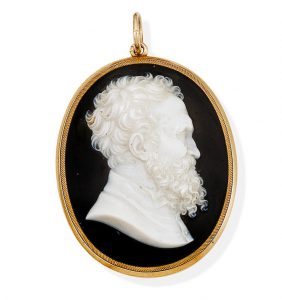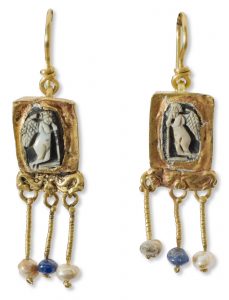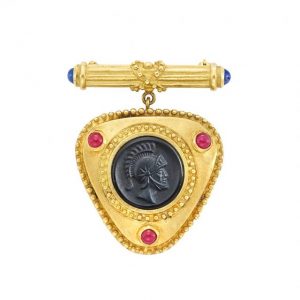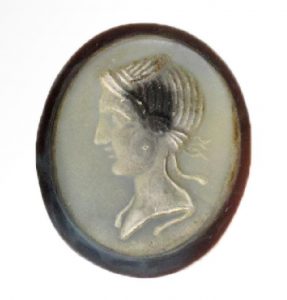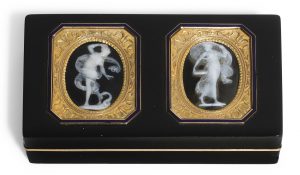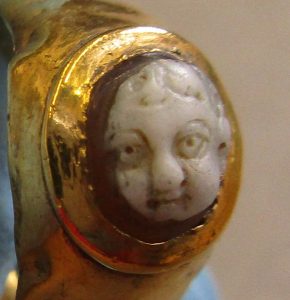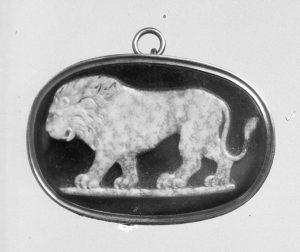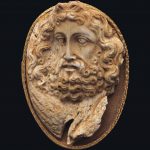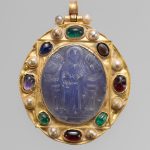Information and history of onyx cameos. Onyx is a banded variety of the oxide mineral chalcedony. Agate and onyx are both varieties of layered chalcedony that differ only in the form of the bands: agate has curved bands and onyx has parallel bands. The colors of its bands range from white to almost every color (save some shades, such as purple or blue). Commonly, specimens of onyx contain bands of black and/or white.
It has a long history of use for hardstone carving and jewelry, where it is usually cut as a cabochon or into beads. It has also been used for intaglio and hardstone cameo engraved gems, where the bands make the image contrast with the ground. Reference: Wikipedia
Onyx is often chosen for cameos because it frequently contains a straight, well-defined vein of white. The subject can be carved from the white vein, and the dark part is then removed from the visual field to create the image. Reference: The Walters Art Museum
An onyx cameo portrait, by Giovanni Antonio Santarelli, late 18th/early 19th century Oval, the cameo portrait of a gentleman carved in onyx, facing right, within a gold pendant frame, signed Santarelli, cameo: length 3.7cm, width 2.9cm, pendant: length 4.9cm, width 3.2cm
Sold for £ 12,500 inc. premium at Bonhams in 2017
A PAIR OF ROMAN GOLD, ONYX CAMEO, SAPPHIRE AND PEARL EARRINGS CIRCA 2ND-3RD CENTURY A.D. Each: 1 ¼ in. (3.2 cm.) long
Sold for USD 8,125 at Christies in 2017
Gold, Black Onyx Cameo and Cabochon Rubies and SapphiresBrooch 3 round cabochon rubies, 3 round cabochon sapphires, ap. 17.3 dwts.
Sold for $750 (includes buyer’s premium) at Doyle New York in 2016
Greek Onyx Intaglio Ringstone, Morpheus, God of Dreams, c. 3rd-1st Century B.C. Origin: Greek, c. 3rd-1st Century B.C. Material: Agate Dimensions: 1.7 cm L – 11/16 inch Provenance: ex. Mrs. Jane Stuart, London UK, 1990s. Oval with two layers of onyx, the upper white layer engraved with the winged bust head of Morpheus in profile, wearing a tiara. Morpheus is the Ancient Greek god of dreams, he has the ability to mimic any human form and appear in dreams.
Sold For $380 at Jasper52 in 2017
A gold-mounted tortoiseshell and cameo snuffbox, Pierre-André Montauban, Paris, 1798-1809 rectangular, the lid inset with two oval onyx cameos, one carved with Eurydice in swirling garments bitten by the serpent, after Giovanni Pichler, the other with the vestal virgin Tuccia with her sieve, after Luigi Pichler, each in a rectangular gold spandrel with cut corners, chased with leaf motifs, within dark blue enamel borders, gold mounts and lining, maker’s mark, bear’s head 3e titre and 3e Paris titre et garantie 1798-1809 8.9cm., 3 1/2 in. long
Sold for 10,000 GBP at Sothebys in 2018
Gold ring, the swelling hoop set with an onyx cameo of a child’s head Place of Origin Europe Date 1st century-2nd century (made)
Reference: © Victoria and Albert Museum
Lions were common subjects for antique cameos. This beautifully carved piece could have been offered for sale as an antique or as a piece in which the art and techniques of antiquity were reflected. Few 17th-century collectors could have told the difference.
Reference: The Walter Art Museum
